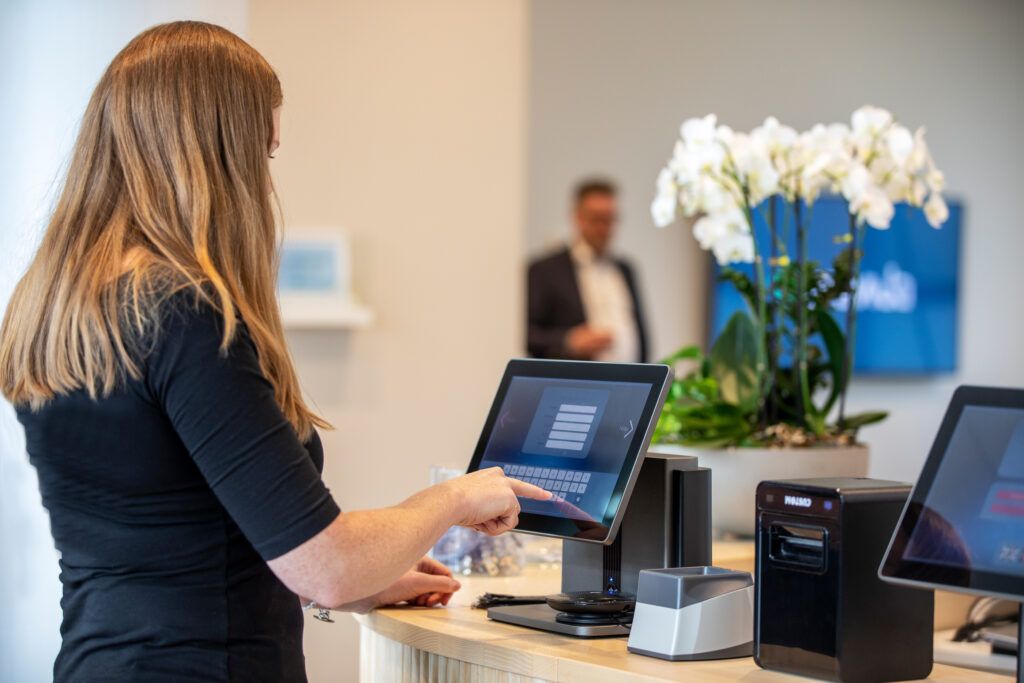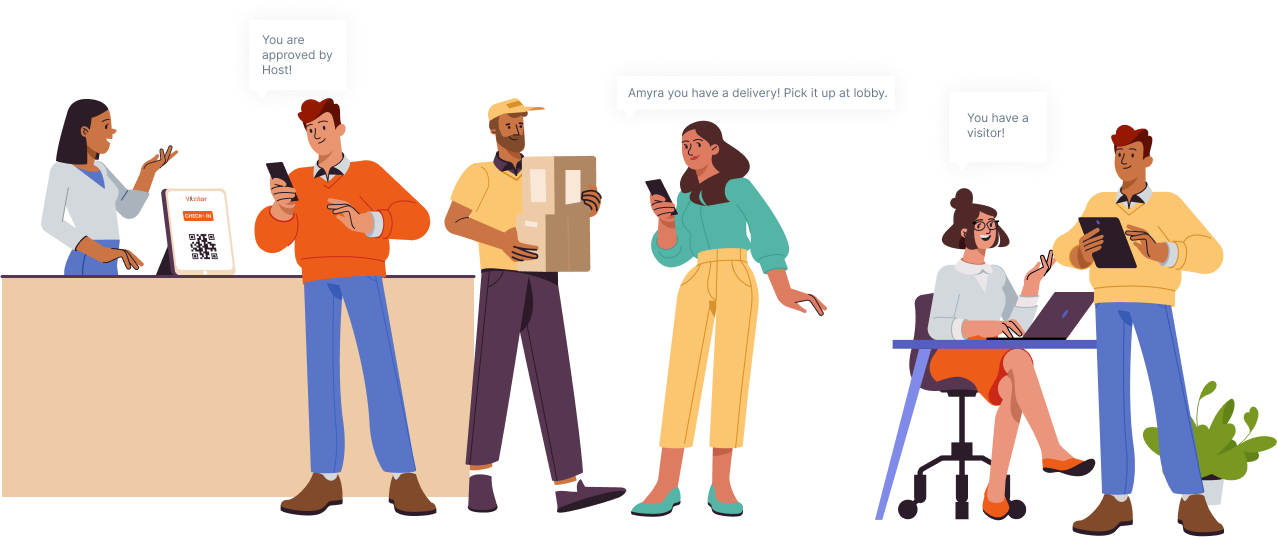Table of Content
Try Vizitor for Free!

Fri, Jan 6, 2023
Read in 9 minutes
Why is a visitor management system crucial for hospitals?
Imagine you are a patient at a busy hospital, trying to rest and recover from a medical procedure. The last thing you want is to be constantly interrupted by well-meaning but unexpected visitors dropping by your room. On the other hand, you also want to be able to see your loved ones and have them visit you to provide support and comfort during your stay.
This is where a visitor management system can come in handy. With a visitor management system in place, hospitals can regulate the flow of visitors, ensuring that patients have the privacy and rest they need while also allowing authorized visitors to see their loved ones.
Testimonials:-
.png)
“Very good app for Visitor Management System & amazing customer service!”
Dr Shashank, AngelLife IVF
#Here’s how it works:
when a visitor arrives at the hospital, they go to the hospital reception desk and check in using the visitor management system. The system verifies the visitor’s identity and checks to see if they are authorized to visit the patient they are there to see. If the visitor is approved, they are issued a badge that allows them access to the appropriate areas of the hospital. This badge also helps hospital staff keep track of who is on the premises and where they are allowed to go.
By using a visitor management system:-
1 hospitals can also track the flow of visitors and contractors, ensuring that only authorized personnel are granted access to certain areas of the facility.
2 This helps improve the overall safety and security of the hospital, as it can prevent unauthorized individuals from gaining access to sensitive areas or patient rooms.
3 In addition to improving patient privacy and security, a visitor management system can also help hospitals manage the spread of infections.
4 Many hospitals require visitors to wash their hands or use hand sanitizer upon entering the facility, and a visitor management system for hospitals can help ensure that this requirement is followed. This can reduce the risk of germs being spread throughout the hospital and help protect both patients and staff
#Touchless Patient Check in Process
-
Touchless Check-In Visitors use their smartphones for themselves check-ins without the help of any third person. Pre-registered visitors can sign in by scanning their QR code. Instead of using a tablet to allow visitors to check-in on their own. This will limit the potential spread of the virus when visitors use their hands to tap the screen.
-
Enter your details and capturing photo After scanning the QR code a customized form will pop up. Just fill in the required details and submit the form to check-in. For enhanced security ask your visitor for a photo. Visitors can simply capture their photo with their mobile phone.
-
Health Screening Form Once a visitor has submitted all the required details you can ask them to fill a Health Screening Form right on their mobile phone. This let’s you understand the health condition of your visitors.
-
Visitor e-Pass After filling out all the required details visitors and employees will be issued an E-Pass which will let them enter the facility with ease.

Maximizing Safety in Hospitals: The Role of a Visitor Management System in the COVID-19 Era
A visitor management system in hospitals can help in a number of ways during the COVID-19 pandemic:
Limiting the number of visitors: A visitor management system can help hospitals control the number of people entering the facility, which can reduce the risk of spreading COVID-19.
Screening visitors for symptoms: Many Touchless visitor management systems include screening questions that can help identify people who may be at risk for COVID-19.
Contact tracing: A Touchless visitor management system can help hospitals track who has been in the facility, which can be helpful for contact tracing purposes if someone tests positive for COVID-19.
Enforcing mask policies: Some visitor management systems can enforce mask policies by requiring visitors to take a self-assessment or scan their temperature before entering the facility.
Protecting patient privacy: A visitor management system can help maintain patient Hospital reception privacy by limiting the number of people who have access to patient rooms and other sensitive areas.
Enhancing security: Many visitor management systems include security features, such as badge scanners and ID checks, which can help hospitals prevent unauthorized access to the facility.
Streamlining check-in and check-out processes: A visitor management system can make it easier for hospitals to track who is in the facility at any given time, which can help streamline check-in and check-out processes and reduce the risk of errors.
Providing real-time data: Many visitor management systems can provide real-time data on the number of visitors in the facility, which can help hospitals make informed decisions about staffing and resource allocation.
How Can Hospitals Benefit From A Digital Visitor Management System?
Visitor management systems for Hospitals are essential for ensuring the security and efficiency of hospitals. These systems leverage the latest technology to streamline the check-in process for patients and visitors, enhance security by verifying the identity of visitors and tracking their movements within the hospital, and improve operational efficiency by reducing workload for staff and providing real-time data and analytics. Despite the numerous benefits these systems offer, their adoption in the healthcare industry, particularly in India, has been slow. Many hospitals in India still rely on traditional methods, such as paper badges, for managing visitors
Here are the ways how a visitor management system can help hospitals and medical facilities secure their premises and fast track their processes at the Hospital reception.
.png)
1. Recognizes various visitor categories and quickly captures extensive data
A digital visitor management system is a software that helps hospitals to track and manage different categories of visitors in real-time. It captures visitor details, such as name, photo, and contact information, and allows hospitals to customize the amount of information they want to collect. This system eliminates the need for paper-based visitor registers and semi-automated systems, and can authenticate, monitor, and track new visitors, patients, staff, medical representatives, vendors, and other types of visitors.
2. Automatically generates multi-purpose passes
A visitor management app can issue touchless passes with validity periods for various types of visitors, including new visitors, patient attendants, staff, and laborers. These passes can be paper, e-passes, or QR code-based and can be integrated with an access control system to restrict unauthorized access to certain areas. Regular visitors, such as patients and patient attendants, can receive long-term passes for easy hospital access. This system is useful for pandemic prevention due to its contactless process.
3. Tracks and monitors multiple gates and locations
A digital visitor management software can manage multiple entry and exit points, including multiple branches, from a single location or dashboard. It should be scalable to handle a large number of locations, and allow real-time viewing of visitor details and reports from various gates and branches.
4. Facilitates self-registration for visitors through kiosk sign-in
Self-registration kiosks can efficiently handle pre-registered visitors and reduce workload for hospital receptionists in India. These kiosks offer benefits like auto-generated passes and language selection, and can be pre-configured for visitor details and departments.
5. Sends emergency alerts and notifications
This digital visitor app allows the host to schedule appointments and receive notifications when the host arrives, and acts as an automated check-in system. It can also send alerts to security guards and broadcast mass messages in emergencies.
6. Enhances Patient Satisfaction
This visitor app allows patients or their attendants to add and give automatic access to a list of desired visitors, as well as identify and block unwanted visitors. This improves patient satisfaction by giving them control and protection.
7. Integration with access control systems
Hospitals have multiple restricted areas such as ICUS, operating rooms, post-operative wards, Dialysis Units, etc. These areas should not be accessible to all visitors. However, such rules are difficult to apply manually, and the chances of someone intruding into a restricted area cannot be entirely eliminated through manual monitoring. A digital visitor management software can be easily integrated with physical access control systems such as biometric systems or door & elevator cards for restricted access without manual monitoring.
8. Displays visitor reports and trends
Hospitals receive a high volume of visitors on a daily basis, and it is important for hospital security and facility managers to track and analyze visitor trends in order to make informed decisions. A digital visitor management software can provide useful reports and statistics through its built-in tools, allowing hospital managers to easily track and analyze visitor data. This information can be useful for identifying patterns, optimizing resources, and improving the overall visitor experience.
9. Reduces long-term costs
Manual processes, such as issuing badges and maintaining semi-automated records, may not seem like significant expenses for hospitals, but they can add up over time and cause delays and inefficiencies. A visitor management software can streamline these processes, reduce the risk of errors and misconduct, and improve cost-effectiveness in the long run. By automating and simplifying day-to-day operations, a visitor management software can help hospitals to run more efficiently and effectively.
10. Enhances hospital reputation and branding
A digital visitor management software can improve the experience of both patients and visitors by providing a professional and efficient way to handle visitors. It can reduce the workload of hospital staff by automating the check-in process, leading to increased patient and visitor satisfaction. This can ultimately enhance the reputation and brand image of the hospital, which is important in a competitive industry.
Conclusions
A “digital” visitor management software, such as Vizitor, can significantly improve the security and visitor management operations of hospitals. With its pay-as-you-go pricing model and the ability to easily implement and adopt the system, it’s no wonder that visitor management software is becoming more popular in a variety of industries.
One of the main advantages of a visitor management system like Vizitor is its ability to enhance the privacy, safety, and health of both patients and visitors. It allows hospitals to regulate the flow of visitors, track the movements of individuals on the premises, and enforce important infection control protocols, creating a safer and more welcoming environment for all.
Overall, considering the numerous benefits that a visitor management system like Vizitor offers, hospitals should definitely consider implementing it as part of their operations management systems.











